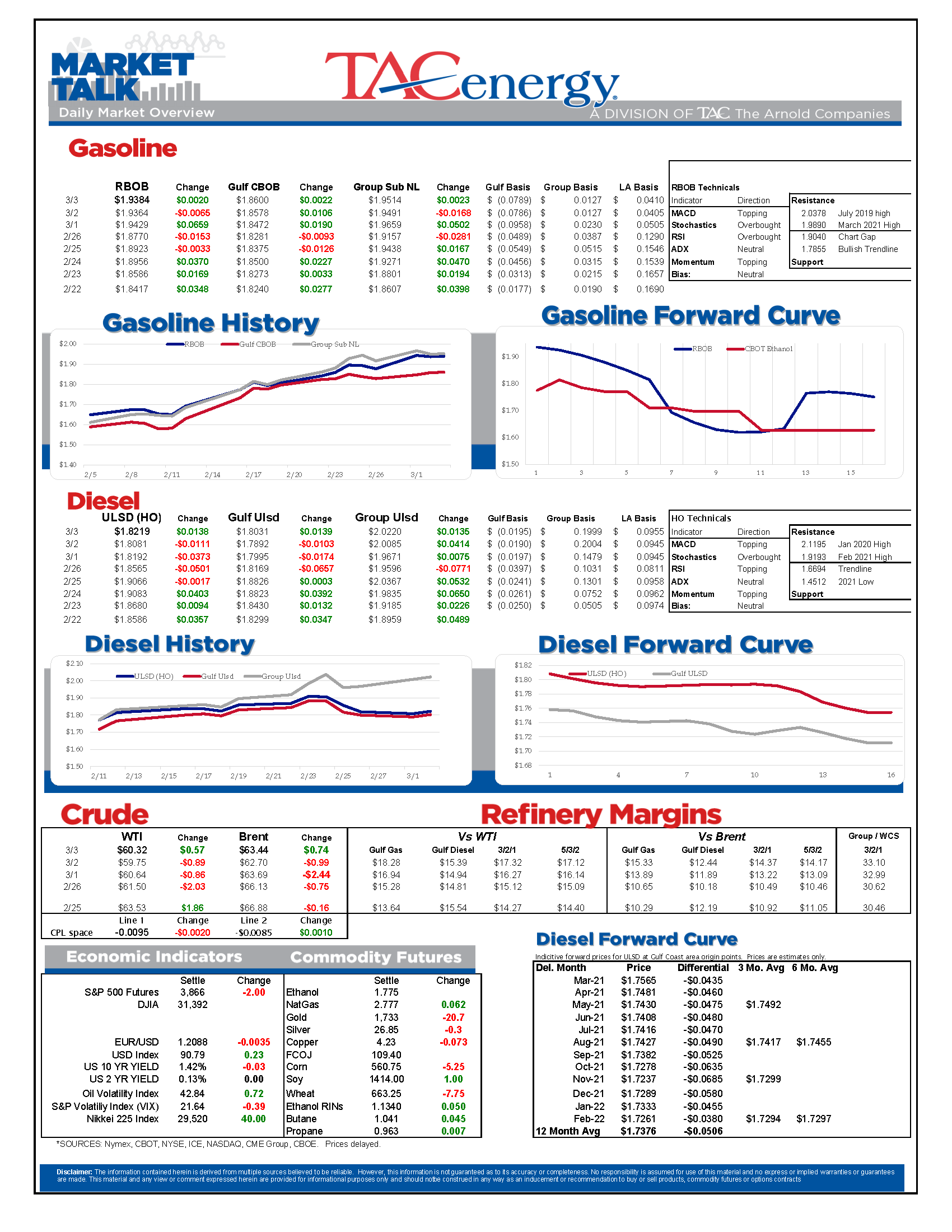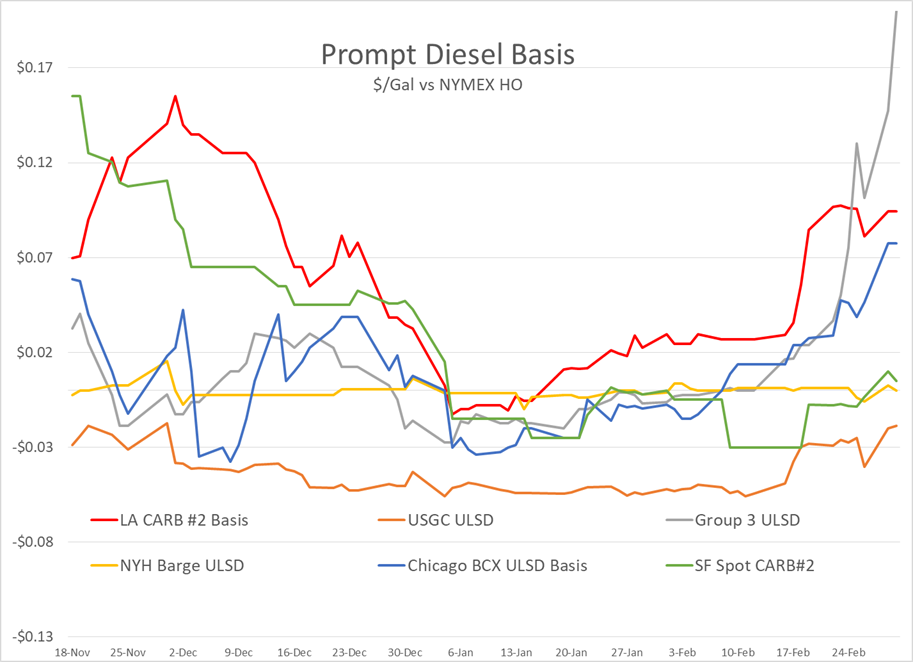Huge Draws In Refined Product Inventories

The four-month-old bullish trend that’s nearly doubled prices for oil and refined products is coming under pressure this week, but so far buyers have been willing to step in each time the chart support is tested. We saw another attempted selloff overnight that pushed WTI below $60, only to see another recovery this morning. This is similar to the back and forth pattern we saw Tuesday morning, which turned into a wave of selling just before the close in the afternoon.
If the bullish trend line finally breaks, we could easily see a $8-10 drop in oil prices and 20-25 cent drop in products over the next month in what could be considered nothing more than an ordinary correction of a major bull market move. If the trend holds however, there’s still a decent fundamental argument for products to rally above $2 this spring and for oil to test $70.
The API’s weekly report was said to show huge draws in refined product inventories last week, as demand recovered faster from the Polar plunge than refineries. Both gasoline and diesel inventories were estimated to be down by more than 9 million barrels/day according to the reports, while crude supplies increased by more than seven million barrels as plants were struggling to restart their processing units. The DOE’s weekly report will be out at its normal time this morning.
Those inventory drawdowns are tangible in markets across the South West and Mid Continent regions, with basis values and rack spreads continuing to spike in several markets this week, with Group 3 ULSD continuing to find itself in the most unusual position as the most expensive diesel in the country, trading at a 20+ cent premium to futures this week. (Charts below) The near term supply situation is getting worse across parts of Texas and the Southwest as refiners continue to struggle with lingering damage that’s slowing restart attempts, and short term outages continue to pop up in New Mexico, Texas, Oklahoma, Arkansas and Louisiana.
For the most part, outages have been limited to diesel and premium gasoline, while regular grades are benefitting from the temporary RVP waivers and relative ease of production they bring. Coastal markets don’t seem to be feeling the squeeze, even though allocations are still not as wide-open as they might normally be this time of year. One thing to watch out for in the coming weeks is premium gasoline supply, which often runs out during the RVP transition given its relatively low demand, and promises to be even more of a challenge this year with refinery output slipping.
RIN prices reached their highest levels since 2013 in Tuesday’s session on the back of stronger grain prices, and expectations for stricter standards to come from the new administration.
The House Committee on Energy and Commerce introduced a new bill that intends to set the U.S. on a path towards zero emissions by 2050, in accordance with the Paris climate agreement. The thousand-plus page bill covers a wide variety of topics, and essentially all sectors of the energy industry, including some tweaks to the RFS. Grant programs to fund various waste-to-fuel programs will be a key topic as the race to produce renewables is setting up a feedstock shortage in the coming years. The bill also includes provisions that refineries requesting exemptions from the Renewable Fuel Standard must share their information publicly.
Meanwhile, the API is reportedly preparing a statement to endorse setting carbon emissions pricing as a way to set a viable economic path towards reaching the Paris agreement. Needless to say, the oil industry group’s plan is expected to look quite a bit different than the one being floated in the House.
OPEC & Friends hold their official meeting tomorrow, so expect the rumor mill to be cranked up over the next 24 hours and keep the oil & product markets on edge.
Click here to download a PDF of today's TACenergy Market Talk.
Latest Posts
Gasoline Futures Are Leading The Way Lower This Morning
The Sell-Off Continues In Energy Markets, RBOB Gasoline Futures Are Now Down Nearly 13 Cents In The Past Two Days
Week 15 - US DOE Inventory Recap
Prices To Lease Space On Colonial’s Main Gasoline Line Continue To Rally This Week
Social Media
News & Views
View All
Gasoline Futures Are Leading The Way Lower This Morning
It was a volatile night for markets around the world as Israel reportedly launched a direct strike against Iran. Many global markets, from equities to currencies to commodities saw big swings as traders initially braced for the worst, then reversed course rapidly once Iran indicated that it was not planning to retaliate. Refined products spiked following the initial reports, with ULSD futures up 11 cents and RBOB up 7 at their highest, only to reverse to losses this morning. Equities saw similar moves in reverse overnight as a flight to safety trade soon gave way to a sigh of relief recovery.
Gasoline futures are leading the way lower this morning, adding to the argument that we may have seen the spring peak in prices a week ago, unless some actual disruption pops up in the coming weeks. The longer term up-trend is still intact and sets a near-term target to the downside roughly 9 cents below current values. ULSD meanwhile is just a nickel away from setting new lows for the year, which would open up a technical trap door for prices to slide another 30 cents as we move towards summer.
A Reuters report this morning suggests that the EPA is ready to announce another temporary waiver of smog-prevention rules that will allow E15 sales this summer as political winds continue to prove stronger than any legitimate environmental agenda. RIN prices had stabilized around 45 cents/RIN for D4 and D6 credits this week and are already trading a penny lower following this report.
Delek’s Big Spring refinery reported maintenance on an FCC unit that would require 3 days of work. That facility, along with several others across TX, have had numerous issues ever since the deep freeze events in 2021 and 2024 did widespread damage. Meanwhile, overnight storms across the Midwest caused at least one terminal to be knocked offline in the St. Louis area, but so far no refinery upsets have been reported.
Meanwhile, in Russia: Refiners are apparently installing anti-drone nets to protect their facilities since apparently their sling shots stopped working.
Click here to download a PDF of today's TACenergy Market Talk.

The Sell-Off Continues In Energy Markets, RBOB Gasoline Futures Are Now Down Nearly 13 Cents In The Past Two Days
The sell-off continues in energy markets. RBOB gasoline futures are now down nearly 13 cents in the past two days, and have fallen 16 cents from a week ago, leading to questions about whether or not we’ve seen the seasonal peak in gasoline prices. ULSD futures are also coming under heavy selling pressure, dropping 15 cents so far this week and are trading at their lowest level since January 3rd.
The drop on the weekly chart certainly takes away the upside momentum for gasoline that still favored a run at the $3 mark just a few days ago, but the longer term up-trend that helped propel a 90-cent increase since mid-December is still intact as long as prices stay above the $2.60 mark for the next week. If diesel prices break below $2.50 there’s a strong possibility that we see another 30 cent price drop in the next couple of weeks.
An unwind of long positions after Iran’s attack on Israel was swatted out of the sky without further escalation (so far anyway) and reports that Russia is resuming refinery runs, both seeming to be contributing factors to the sharp pullback in prices.
Along with the uncertainty about where the next attacks may or may not occur, and if they will have any meaningful impact on supply, come no shortage of rumors about potential SPR releases or how OPEC might respond to the crisis. The only thing that’s certain at this point, is that there’s much more spare capacity for both oil production and refining now than there was 2 years ago, which seems to be helping keep a lid on prices despite so much tension.
In addition, for those that remember the chaos in oil markets 50 years ago sparked by similar events in and around Israel, read this note from the NY Times on why things are different this time around.
The DOE’s weekly status report was largely ignored in the midst of the big sell-off Wednesday, with few noteworthy items in the report.
Diesel demand did see a strong recovery from last week’s throwaway figure that proves the vulnerability of the weekly estimates, particularly the week after a holiday, but that did nothing to slow the sell-off in ULSD futures.
Perhaps the biggest next of the week was that the agency made its seasonal changes to nameplate refining capacity as facilities emerged from their spring maintenance.
PADD 2 saw an increase of 36mb/day, and PADD 3 increased by 72mb/day, both of which set new records for regional capacity. PADD 5 meanwhile continued its slow-motion decline, losing another 30mb/day of capacity as California’s war of attrition against the industry continues. It’s worth noting that given the glacial pace of EIA reporting on the topic, we’re unlikely to see the impact of Rodeo’s conversion in the official numbers until next year.
Speaking of which, if you believe the PADD 5 diesel chart below that suggests the region is running out of the fuel, when in fact there’s an excess in most local markets, you haven’t been paying attention. Gasoline inventories on the West Coast however do appear consistent with reality as less refining output and a lack of resupply options both continue to create headaches for suppliers.





